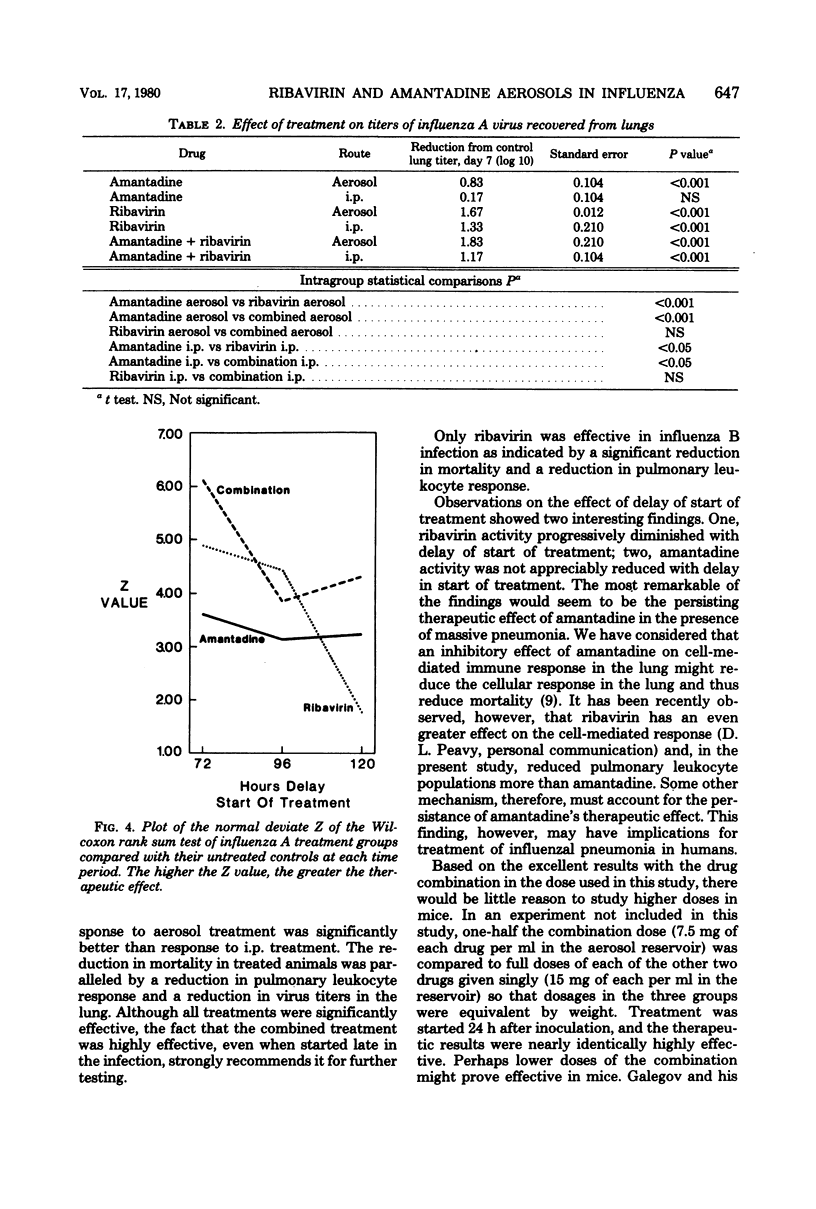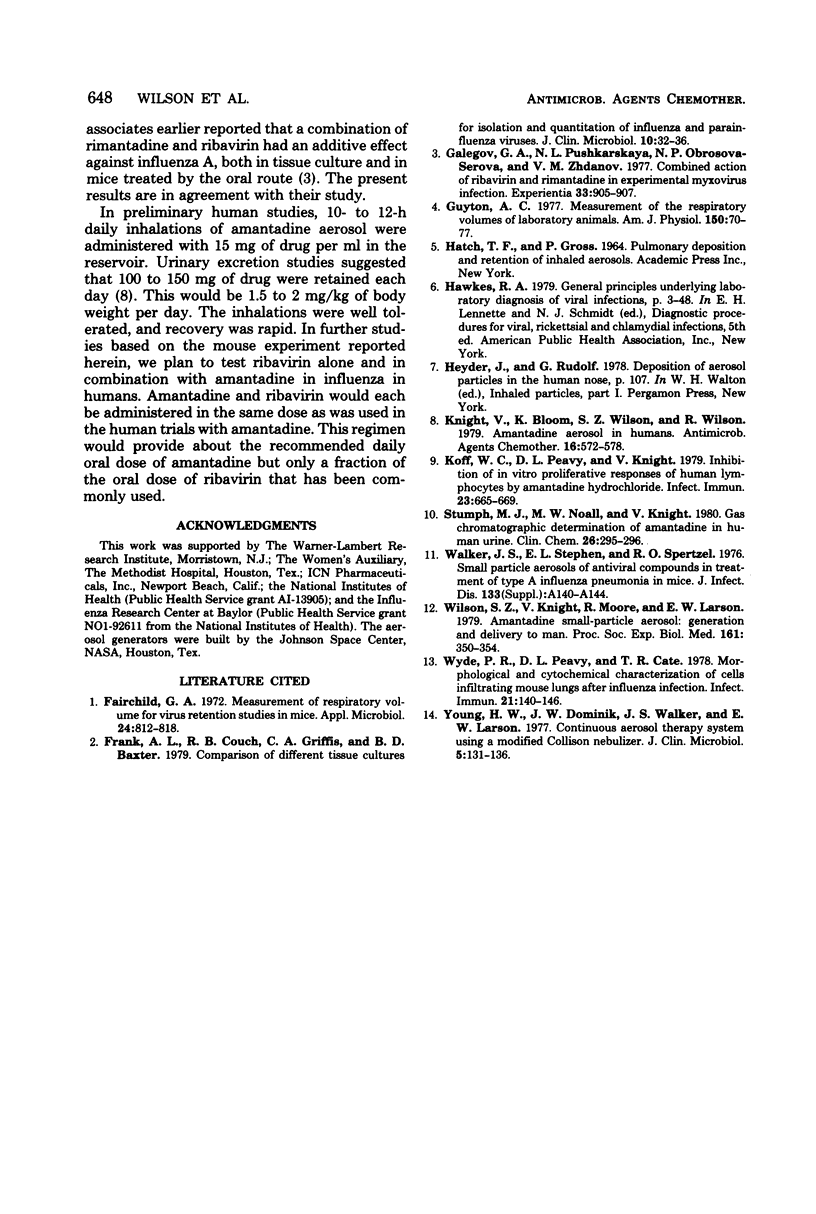Abstract
Ribavirin, amantadine, and the two drugs in combination given in small-particle aerosol were highly effective in the treatment of influenza A infection in mice. Treatment was started 72, 96, and 120 h after inoculation and was given continuously for 4 days. With increasing delay in start of treatment, there was a pronounced reduction in effectiveness of ribavirin but not in that of amantadine. The combination treatment reflected the loss of ribavirin activity. Leukocyte infiltration and virus titers in the lungs were inversely related to the effectiveness of treatment. Influenza B infection treated 72 h after inoculation responded only to ribavirin, as indicated by the criteria described for influenza A. Intraperitoneal administration of drug begun 72 h after inoculation in regimens equivalent to aerosol afforded less protection than aerosol treatment.
Full text
PDF






Selected References
These references are in PubMed. This may not be the complete list of references from this article.
- Fairchild G. A. Measurement of respiratory volume for virus retention studies in mice. Appl Microbiol. 1972 Nov;24(5):812–818. doi: 10.1128/am.24.5.812-818.1972. [DOI] [PMC free article] [PubMed] [Google Scholar]
- Frank A. L., Couch R. B., Griffis C. A., Baxter B. D. Comparison of different tissue cultures for isolation and quantitation of influenza and parainfluenza viruses. J Clin Microbiol. 1979 Jul;10(1):32–36. doi: 10.1128/jcm.10.1.32-36.1979. [DOI] [PMC free article] [PubMed] [Google Scholar]
- Galegov G. A., Pushkarskaya N. L., Obrosova-Serova N. P., Zhdanov V. M. Combined action of ribovirin and rimantadine in experimental myxovirus infection. Experientia. 1977 Jul 15;33(7):905–906. doi: 10.1007/BF01951273. [DOI] [PubMed] [Google Scholar]
- Knight V., Bloom K., Wilson S. Z., Wilson R. K. Amantadine aerosol in humans. Antimicrob Agents Chemother. 1979 Nov;16(5):572–578. doi: 10.1128/aac.16.5.572. [DOI] [PMC free article] [PubMed] [Google Scholar]
- Koff W. C., Peavy D. L., Knight V. Inhibition of in vitro proliferative responses of human lymphocytes by rimantadine hydrochloride. Infect Immun. 1979 Mar;23(3):665–669. doi: 10.1128/iai.23.3.665-669.1979. [DOI] [PMC free article] [PubMed] [Google Scholar]
- Stumph M. J., Noall M. W., Knight V. Gas-chromatographic determination of amantadine in human urine. Clin Chem. 1980 Feb;26(2):295–296. [PubMed] [Google Scholar]
- Walker J. S., Stephen E. L., Spertzel R. O. Small-particle aerosols of antiviral compounds in treatment of type A influenza pneumonia in mice. J Infect Dis. 1976 Jun;133 (Suppl):A140–A144. doi: 10.1093/infdis/133.supplement_2.a140. [DOI] [PubMed] [Google Scholar]
- Wilson S. Z., Knight V., Moore R., Larson E. W. Amantadine small-particle aerosol: generation and delivery to man. Proc Soc Exp Biol Med. 1979 Jul;161(3):350–354. doi: 10.3181/00379727-161-40551. [DOI] [PubMed] [Google Scholar]
- Wyde P. R., Peavy D. L., Cate T. R. Morphological and cytochemical characterization of cells infiltrating mouse lungs after influenza infection. Infect Immun. 1978 Jul;21(1):140–146. doi: 10.1128/iai.21.1.140-146.1978. [DOI] [PMC free article] [PubMed] [Google Scholar]
- Young H. W., Dominik J. W., Walker J. S., Larson E. W. Continuous aerosol therapy system using a modified Collison nebulizer. J Clin Microbiol. 1977 Feb;5(2):131–136. doi: 10.1128/jcm.5.2.131-136.1977. [DOI] [PMC free article] [PubMed] [Google Scholar]


